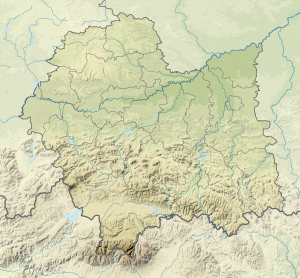Hołowczyc Palace
| Hołowczyc Palace | ||
|---|---|---|
|
The six-column portico defines the facade on Nowy Świat Boulevard |
||
| Creation time : | 1743 | |
| Castle type : | palace | |
| Conservation status: | Reconstructed | |
| Place: | Warsaw | |
| Geographical location | 52 ° 14 '1.6 " N , 21 ° 1' 7.8" E | |
|
|
||
The Hołowczyc Palace (also called Palais Bürger , Polish Pałac Hołowczyca ) is a building erected in 1820 on Ulica Nowy Świat 35 (formerly: Nowy Świat 31 ) in the Warsaw inner city district . The original apartment building, built in the form of an elegant city palace, is now used primarily for office purposes. The property is listed.
history
The history of the building is controversial. Originally there were urban farm buildings here (on the historical part of the Warsaw Royal Route ); in 1743 the property belonged to the Augustinian order . The owner of the current building was presumably Karl Burger, General Treasurer of the Royal Postal Administration. It later passed to Archbishop Szczepan Hołowczyc, who lived here until his death. The building was named after him. After Hołowczyc's death in 1823, Józef Dąbski became the owner.
The Russian General Władimir Knorring , chief of a cavalry unit (Podolian Cuirassier Regiment of the 1st Brigade of the Russian Guard Division) also lived here. In the 1870s, the confectioner Antoni Kazimierz Blikle founded what would become Warsaw's most famous patisserie in the palace. The Cukiernia A. Blikle is still located in the southern part of the building and extends to house number 33. In addition, Ignacy Kaperski's furniture store, Mazowiecka school and Marian Malinowski's pharmacy were located in the palace as well as elegant apartments.
In the interwar period there was a library on the ground floor. During the Warsaw Uprising in 1944, the building was burned down by units of the Wehrmacht . In 1949 the reconstruction took place under Piotr Biegański . As a result, various institutions were located in the house, such as the Polish Hunting Association and an attached hunting museum (today incorporated in the Hunting and Equestrian Museum in Warsaw ) and the Polish Automobile Association (Polish Polski Związek Motorowy ). Today it is mainly used as an office building, numerous organizations and companies have their headquarters here.
The design for the palatial multi-party residential building came from Antonio Corazzi or Friedrich Albert Lessel . The three-storey building, the front facade of which is in the line of buildings from Nowy Świat , has a central projectile designed as a monumental portico with six Doric columns in front of an indented facade wall. The columns extend over the two upper floors, on the first floor the French windows have a balcony-like exit; on the ground floor the risalit has a building passage. Tuscan style elements were occasionally used.
literature
- Julius A. Chroscicki and Andrzej Rottermund, Architectural Atlas of Warsaw , 1st edition, Arkady, Warsaw 1978, p. 180
- Janina Rutkowska, City Guide Warsaw , 2nd edition, Verlag Sport i Turystyka, Warsaw 1972, p. 84
Web links
- Information about the palace with historical photo at Warsawa1939.pl (in Polish)



